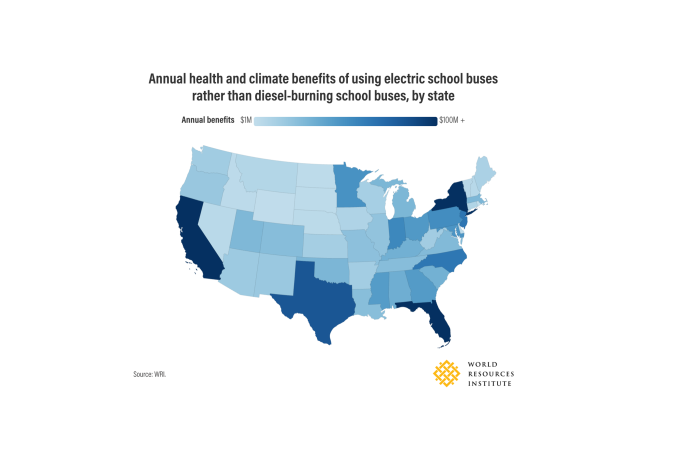Technical Note for a Dataset Modeling the Societal Health and Climate Benefits Associated With Transitioning the US School Bus Fleet From Diesel to Electric
This technical note describes the methods used to model the societal health and climate benefits associated with transitioning the US school bus fleet from diesel to electric. The dataset presents a range of results that quantify the impacts of school bus operations in each county in the contiguous United States.

Approximately 90 percent of the half million school buses operating in the United States run on diesel, a fossil fuel known to emit harmful pollutants such as particulate matter, nitrogen oxides, and volatile organic compounds. These emissions, particularly from older buses, pose significant health risks to children and drivers, including of respiratory and cognitive impairment. Diesel exhaust has been classified as a carcinogen by the World Health Organization.
Research shows that older diesel buses emit substantially more pollution than newer models, exacerbating public health burdens. In contrast, electric school buses produce zero tailpipe emissions and have the lowest greenhouse gas emissions of any school bus type, even when accounting for electricity generation. As a result, there is growing momentum toward electrifying school bus fleets, supported by increased public funding and policy interest.
This research is one of the first to model and quantify the health and climate impacts of replacing aging diesel school buses with either new diesel or new electric buses, incorporating both upstream and tailpipe emissions at the US county level. Using reverse source influence modeling, the research estimates the societal benefits of various fleet renewal scenarios. Key questions include which regions would benefit most from electrification and what the national emissions would be under different replacement strategies.
The findings are intended to inform policymakers, school districts, manufacturers, and utilities by providing monetized estimates of health and climate impacts, enabling data-driven decisions about school bus fleet modernization. Various forms of results are discussed in this technical note and its appendices. For all categories of results, they are provided for each model year and each subfleet grouping.
The datasets produced include the following:
- Diesel school bus impacts: Diesel school bus impacts are calculated as unit impacts and total impacts.
Unit impacts for each county are provided in three forms: per ton-CO2 emitted (i.e., co-benefits, in units of $/ton-CO2 ), per school bus ($/bus-year), or per VMT ($/1,000 VMT). - Total impacts for each county are impacts from all buses in a model year or subfleet category in that county and are expressed in units of $/year.
- Total impacts are broken down to health, climate, or overall (health + climate) impacts.
- Electrification benefits: Societal benefits of replacing diesel school buses with electric school buses are calculated as the difference between their respective societal impacts. Electrification benefits are made up of both climate and health benefits of school bus replacement. Similar to the diesel school bus results, these benefits are provided for all US counties, and as unit impacts (per bus or per VMT) and total impacts ($/year) for model year or subfleet categories.